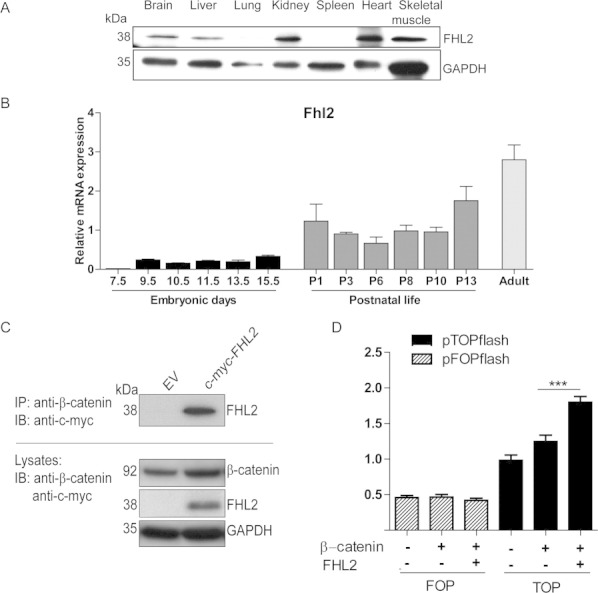Figure 1.

FHL2 is expressed in cardiac tissue, interacts with β-catenin, and enhances its transcriptional activity in heart cells. (A): Protein expression analysis of FHL2 via Western blot in different adult organs in mice normalized to GAPDH. (B): qPCR analysis of Fhl2 in embryonic cardiac developing tissue, early postnatal, and adult mouse heart. Relative mRNA levels were normalized to tumor protein, translationally controlled 1 (Tpt1), a gene expressed with insignificant variation along development and adulthood. (C): FHL2 and β-catenin interact in neonatal rat cardiomyocyte (NRCM) cultures. NRCM cultures were transfected with a c-myc-FHL2-expressing plasmid and an EV (as control), subsequently endogenous β-catenin was co-IP and FHL2 was IB with a c-myc-antibody. Both proteins were also detected in protein lysates from NRCM cultures. (D): FHL2 activates β-catenin-dependent transcription in NRCM cultures. Luciferase activity measurement demonstrated significant activation of the pTOPflash luciferase LEF/TCF reporter activity upon FHL2 and β-catenin coexpression in NRCM. The FOPflash-plasmid containing mutated TCF binding sites served as control and Renilla luciferase was used for normalization. Data represent mean ± SEM, n = 3, ***, p < .001 (ANOVA; Bonferroni's multiple comparison test). Abbreviations: EV, empty vector; FHL2, four-and-a-half-LIM-domain 2; IB, immunodetected; IP, immunoprecipitated.
